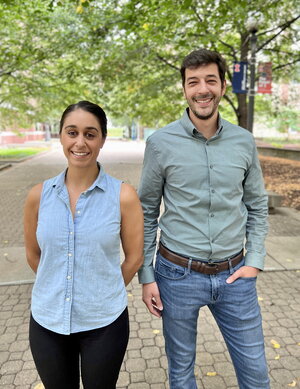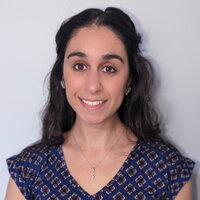The Illinois chemistry community is excited to welcome two new faculty members who are beginning their independent careers in the 2023-24 academic year following postdoctoral research experiences in highly ranked chemistry programs.
Majed Fataftah arrives at Illinois from Yale University where he was a National Institutes of Health postdoctoral fellow in the lab of Prof. Patrick L. Holland, investigating synthetic models of the C cluster in carbon monoxide dehydrogenase.
Anastasia C. Manesis comes to Illinois from Northwestern University, where she worked in the lab of Prof. Amy Rosenzweig as a Simons Foundation awardee of the Life Sciences Research Foundation and was a recipient of the McBride postdoctoral trainee award.
Fataftah was born in Seattle and spent his childhood years in the outskirts of the West Bank in Palestine, returning in later years to Seattle where he received a BS in chemistry and biochemistry from the University of Washington in 2013.
As an undergraduate, Fataftah conducted research in the lab of Prof. Daniel R. Gamelin, studying energy transfer dynamics in semiconducting nanocrystals. He pursued his PhD at Northwestern University under the tutelage of Prof. Danna E. Freedman designing molecular qubits for quantum information science.
Fataftah, who will teach Chem 512–Advanced Inorganic Chemistry to the incoming graduate class this fall semester, said he is very excited to start his independent career in the Department of Chemistry at Illinois.
“I am really grateful for this opportunity to pursue my research interests at Illinois where the breadth of expertise across the Department of Chemistry is impressive. One of the things I am looking forward to is applying, and honing, my skills as a teacher and mentor,” Fataftah said.
Manesis, who is originally from New Jersey, completed a BS in biochemistry and a BA in Asian studies with a minor in Chinese language at Northeastern University, graduating magna cum laude as a Huntington 100 fellow. She pursued her PhD at Ohio State University in the lab of Prof. Hannah Shafaat, receiving the graduate student award for mentoring excellence.
Manesis said it feels “completely unreal” to begin this chapter of her career, but she also feels Illinois is well-equipped to help her handle any challenges as she embarks on this next step in her scientific journey.
This academic year, she will be teaching Chem 518: Bioinorganic chemistry and looks forward to inspiring the next generation of scientists.
“I have a passion for mentoring and look forward to watching my students grow as scientists and tackle big scientific questions,” said Manesis, who added that she strongly believes the Department of Chemistry at Illinois is going to be an ideal environment to launch her independent faculty career. “Not just because of the outstanding resources, but also because of the distinguished community of scholars and the world-class students.”
At Illinois, the Fataftah group’s research program will focus on utilizing synthetic and physical inorganic chemistry methods to address challenges in quantum information science, magnetic materials, and bioinorganic chemistry.
His doctoral work focused on the synthesis and characterization of paramagnetic coordination compounds and establishing magneto-structural correlations to guide the design of molecular qubits, the basic unit of a quantum information science system.
“These studies allowed us to understand how to leverage the ligand field environment in coordination compounds to create multiple qubits within a single molecule, and the impact of the ligand field on spin dynamics.”
As an NIH postdoctoral fellow, Fataftah synthesized and studied synthetic small molecule mimics of complex metalloenzymes active sites, such as the FeMoco (nitrogenase) and the C cluster (carbon monoxide dehydrogenase).
“These small molecule mimics allow us to study key structural and electronic structure facets and their relevance to the native enzyme’s catalytic activity,” he said.
Bioinorganic chemistry and biochemistry are the areas of expertise for Manesis, whose doctoral research focused on engineering metalloprotein scaffolds to better understand the underlying mechanisms relevant for energy-related catalysis.
“Specifically, I worked on modelling a nickel-containing system called acetyl coenzyme A synthase using the small metalloprotein, azurin. Overall, my dissertation project highlighted a central goal of bioinorganic chemistry-- to marry what we, as synthetic inorganic chemists, know about cofactor structure with what we, as biochemists, know about the importance of the secondary coordination sphere of proteins in modulating catalytic activity,” she explained.
As a postdoctoral fellow, she focused her work on understanding microbial copper transport, specifically in microorganisms called methanotrophs, which are organisms that play a critical role in methane conversion.
At Illinois, research in the Manesis group will combine approaches from inorganic chemistry, biochemistry, and microbiology to focus on identifying novel metallocofactors within large, unexplored protein superfamilies through rigorous genome mining and bioinformatics approaches.
“I am motivated by nature’s ability to repurpose a limited set of ligands and metals to accomplish a variety of chemical reactions. With an emphasis on identifying new metalloenzyme cofactors involved in microbial metabolisms such as the oxidative stress response and metal homeostasis, we can rationalize how nature has diversified the chemistry it accomplishes using a single cofactor,” she explained.
Meet two more professors — Christy Landes and Stephan Link — who are joining the Illinois chemistry faculty in the 2023-24 academic year.


